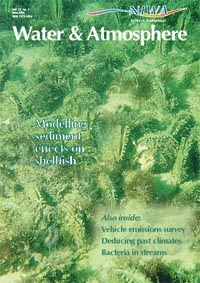
On this page
- Fish on the move
- New NIWA posters
- NIWA studies the top of the South
- Just published: Freshwaters of New Zealand
- The Living Reef shortlisted for the Montana Book Awards
- Shipboard air sampling through the western Pacific
- Study of nutrient enrichment in South Island coastal lakes
- NIWA and GNS co-host stable isotope conference
- The Southern Ocean and climate change
- Kelp on reefs under the February 2004 flood
- Recent publications by NIWA staff
Fish on the move

During May 2004, NIWA successfully delivered over 27,000 kingfish fingerlings (juveniles) from production facilities at NIWA’s Bream Bay Aquaculture Park to a commercial client in the far north of the North Island. The NIWA salmon transport vehicle, a specially modified milk tanker, was brought up from Silverstream (near Christchurch) for two transports of 18,000 and 9,000 kingfish fingerlings. There was less than 0.01% mortality from the two 5-hour deliveries – no mean feat considering the very high metabolic rate of these small fish and the high fish densities. This delivery followed a similarly successful 22-hour transport of kingfish from Bream Bay to a client in Marlborough Sounds in 2003.
These journeys, along with experiments, have shown that one of the main causes of stress to the fish was the accumulation of carbon dioxide. Careful monitoring of pH and the use of agitators kept the carbon dioxide concentrations within safe limits.
The number of fingerlings transported is expected to increase substantially over the next few years. To ensure continued success we are undertaking further experiments to allow fish to be carried at even higher densities with minimal stress. These include measuring oxygen consumption and ammonia excretion rates for fingerlings, as well as testing the effectiveness of different methods of carbon dioxide stripping. Data collected on physiological stress indicators will also be analysed to determine how quickly the fish recover from transportation.
While NIWA has had a track record of successful salmon transport for 10 years, the high water temperatures and high metabolic rates of kingfish demand the development of more sophisticated systems. The knowledge and experience gained from transporting kingfish will make NIWA one of the leading authorities in New Zealand on the live transport of high-metabolism fish such as kingfish and tuna.
Nelson Boustead and Damian Moran
For more information about fish transport by NIWA, contact: Nelson Boustead NIWA, PO Box 8602, Christchurch [email protected]

New NIWA posters
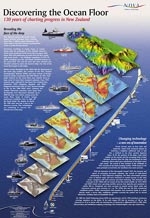
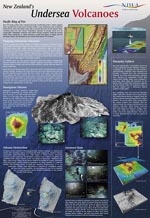
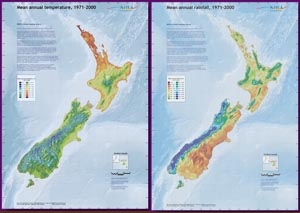
NIWA has published two new poster charts highlighting aspects of its marine geology and biology research of interest to the general public, schools, and the science community. Both posters have been distributed to every secondary school in New Zealand.
“Discovering the Ocean Floor – 130 years of charting progress” displays the remarkable progress in mapping the seafloor around New Zealand since the late 19th century. In 1874, HMS Challenger conducted the first oceanographic survey of the world ocean. This was the start of systematic charting of the southwest Pacific Ocean, although James Cook and other explorers had earlier charted New Zealand’s coastal waters. Since then, successive surveys by naval and oceanographic ships have greatly improved our knowledge of the 4 million square kilometres of ocean enclosed by the New Zealand Exclusive Economic Zone. Spectacular advances in the last decade, in particular, have enabled mapping of the entire EEZ in unprecedented detail and accuracy. Using historical charts, the poster traces the evolution of surveying technologies from sextant and lead-line surveys of the Challenger to the satellite-guided, multibeam surveys carried out by NIWA’s research vessel Tangaroa. With this precision, detail and coverage, New Zealand enters a new age of ocean discovery.
“New Zealand’s Undersea Volcanoes” highlights the discovery of submarine volcanoes north of New Zealand along the Pacific Ring of Fire. These features, located along the Kermadec Ridge, include 10 volcanoes with basal diameters of more than 10 km. Haungaroa is the largest volcano discovered, being at least 25 km wide and 2400 m high. The poster shows different types of volcanism operating in the Kermadec system, including explosive caldera eruptions (like Lake Taupo) and cone-building volcanoes (like Ruapehu). New seafloor images of recently erupted submarine lava flows are shown, as are the first attempts to quantify the volumes of submarine volcanic landslides, which may have implications for tsunami risk in the Bay of Plenty. Additionally, the poster highlights the unique ecosystems associated with submarine volcanoes. Newly discovered hydrothermal vent sites, with animal communities containing species previously unknown to science, emphasise how scant our knowledge is of the deep ocean.
The posters can be purchased for $28 each from this website (see more details and order form) or by contacting: Kay Tredrea NIWA, Private Bag 14901, Wellington ph +64 4 386 0300 [email protected]
Have you ever wondered what the yearly rainfall is at your place, or which is the hottest part of the country? NIWA’s climate mapping service has produced two posters that show all that information, based on data from 1971 to 2000.
The two posters can be purchased as a set for $28 from this website (see more details and order form) or by contacting: Science Communication NIWA, Private Bag 14901, Wellington ph +64 4 386 0300 [email protected].

NIWA studies top of the South
Coastal currents and weather systems keep the waters of Tasman and Golden Bays on the move. To understand how this might affect aquaculture, water quality and coastal hazards in the Bays, NIWA undertook a comprehensive sampling programme in the area from summer 2001 to spring 2002. This included four research voyages on the RV Kaharoa – the first combined biological–oceanographic research surveys to consider Cook Strait, Tasman Bay and Golden Bay as a single entity.
Understanding the biological system in the Bays is especially important because they are aquaculture regions and also include the nationally significant Abel Tasman National Park.
We expected to find that the water quality and ecology of the Bays depended on their interaction with Cook Strait waters as well as on what was happening within the Bays and their catchments. Hence, the sampling covered a wide area. We also knew that marine conditions can change rapidly between and within seasons. Therefore the seasonal ocean sampling from the Kaharoa was supplemented with instrument-mooring and remote-sensing data. Overall, the programme produced information at frequencies from minutes to months, across the entire region. Combining the field measurements with hydrological and meteorological information from NIWA databases will enable us to set conditions for current-flow and water-quality models covering the greater Cook Strait area.
The eventual aim is to design biological models of the Bays region, similar to those already created by NIWA in other areas such as Hauraki Gulf. Along with ongoing environmental monitoring within the Bays, the large-scale picture provided by such models will help to identify the sources of environmental variations caused by river flows, the activities of farms, or larger-scale changes that arise from the ocean flows and weather systems of central New Zealand.
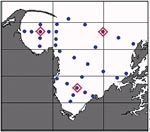
John Zeldis, Rob Bell, Alex Ross, Roy Walters, Malcolm Greig, Matt Pinkerton, and Mark Gall
For further information, contact: John Zeldis NIWA, PO Box 8602, Christchurch ph +64 3 348 8987 [email protected]

Just published: Freshwaters of New Zealand

The 46 chapters in this new book provide the most comprehensive coverage to date of science and management issues related to New Zealand’s freshwater resources.
From glaciers to groundwaters, from birds to bugs, and from the hydrological cycle to hydro-power schemes: it’s all included. Eighty contributors – including many from NIWA – have worked with the four editors over the past 12 months to complete the volume. Produced with support from both the New Zealand Hydrological Society and the New Zealand Limnological Society, Freshwaters of New Zealand is expected to become a standard text for students, managers and scientists working in a wide range of fields.
Harding, J.S.; Mosley, M.P.; Pearson, C.P.; Sorrell, B.K. (editors) (2004). Freshwaters of New Zealand. New Zealand Hydrological Society and New Zealand Limnological Society, Wellington. 764 p.
Copies are available ($69.95 + postage and packing) from: The Administrator New Zealand Hydrological Society, PO Box 12300, Wellington 6038 [email protected]

The Living Reef shortlisted for the Montana Book Awards
The Living Reef, edited by NIWA scientists Drs Neil Andrew and Malcolm Francis, was published in December 2003. This stunning insight into the unique undersea world of New Zealand’s rocky reefs has now been selected as one of three finalists in the Environment section of the Montana Book Awards.
The book’s awe-inspiring photographs showcase the astounding array of marine organisms in our coastal waters, but The Living Reef is not just beautiful; it is a landmark publication in the field of marine biology and ecology which can be easily read by non-scientists.
It describes in detail key species of plants and animals found on and around these shallow, subtidal reefs, including giant kelp, kina, crayfish, sea horses, and snapper. It also profiles some special places that have captured the imagination of explorers, divers and scientists, ranging from the subtropical Kermadec Islands to Antarctica. There’s an overview of the large-scale processes that shape our coastline as well.
NIWA and the Ministry of Fisheries provided financial and technical support towards its publication.
The Living Reef retails at $59.95 and is available from all good bookstores.

Shipboard air sampling through the western Pacific
In May 2004 Tony Bromley (NIWA, Wellington) left the port of Nelson on board the bulk car carrier FujitransWorld bound for Osaka, Japan. The voyage marked the start of a collaborative project with scientists from Japan’s National Institute for Environmental Studies (NIES) based in Tsukuba near Tokyo. NIES scientists have installed an automatic sampling system onboard FujitransWorld to collect small-volume air samples. NIWA’s involvement is the collection of large air samples (3 cubic metres) using a special clean-air compressor.
The voyage to Osaka takes the ship through meteorological convergence zones in the tropics. The Intertropical Convergence Zone (ITCZ) extends around the “waist” of the Earth and acts as a kind of buffer, restricting movement of air between the Northern and Southern Hemispheres. New stable isotopic and other analyses on the collected air will allow us to determine the impact of atmospheric chemistry on gases (such as methane) as they cross from northern into southern regions.
Large samples were collected every 2.5° of latitude (approximately 8-hour intervals) from 30°S to 30°N. Two glass-flask samples were also collected at each position These were for another integrated collaborative sampling venture with two institutes in Colorado, USA: NOAA/CMDL and University of Colorado INSTAAR division.
The large samples are being analysed at NIWA’s trace-gas laboratory in Wellington and the glass flasks were sent to Colorado for analysis.
The FujitransWorld is an ideal platform for air sampling as the superstructure is close to the bow, with the engine room and funnel almost 200 m away near the stern. Contamination from the ship’s exhaust is kept well aft from the sampling tube inlet near the bow under all wind conditions, provided the vessel is moving forward.
Up to four sampling voyages per year are envisaged over the next few years.
For further information, contact: Dave Lowe NIWA, Private Bag 14901, Wellington ph +64 4 386 0399 [email protected]

Study of nutrient enrichment in South Island coastal lakes
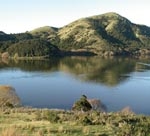
A joint NIWA/University of Otago study is currently examining the ecology, biodiversity and foodwebs of coastal lakes in the South Island. Lowland lakes and coastal lagoons are especially prone to eutrophication from nutrient runoff yet, to date, there is little documented information on the resulting changes to the biodiversity and foodwebs of these systems in New Zealand.
The first part of the study, now underway, involves surveying riparian habitats, water chemistry, plankton, aquatic plants, invertebrates (insects, molluscs, crustaceans), and fish in up to 20 coastal lakes in Canterbury, Otago, Southland and Westland. We plan to use the data to examine how differences in nutrient enrichment status and water quality changes affect the species that live in these systems. The surveys will also give information on how energy flows through the foodweb to important species such as eels, other native fish species (e.g., inanga, giant kokopu), and trout. For example, we know that nutrient inputs stimulate planktonic algal growth, which can reduce water clarity, and in turn can adversely affect the aquatic plants that grow on the lake bottom. It is also well known that these aquatic plants provide habitat for invertebrates and fish, and can be important as a food source for some bird species. Yet we are uncertain about how changes from clear-water, nutrient-poor systems dominated by rooted aquatic plants, to nutrient-rich systems dominated by planktonic plants (algae) might affect important mahinga kai species such as eels. Knowledge of food-web dynamics in these lakes should help us to find out. We will also describe conditions in some of the most pristine coastal lake systems. These reference sites can then be used to set targets for the future restoration of degraded systems.
Lakes included in the survey are: West Coast – Mahinapua, Ianthe, Poerua, Ryan, Lady Lake; Canterbury – Te Wairewa (Forsyth), Coopers and Tutai Paku Lagoons, Te Waihora (Ellesmere), Rotorua (see photo); Otago – Waihola, Waipori, Tuakitoto, Wainono and Tomahawk Lagoons; Southland – Wilkie, Vincent, George, The Reservoir.
For further information, contact: David Kelly NIWA, PO Box 8602, Christchurch ph +64 3 348 8987 [email protected] or Marc Schallenberg University of Otago ph +64 3 479 7989 [email protected]

NIWA and GNS co-host stable isotope conference
“Applications of Stable Isotopes to Ecological Studies”, held in April 2004 at Te Papa Tongarewa in Wellington, proved a very successful conference. This biannual event brings together a wide range of international ecologists who use stable isotopes to identify and solve gaps in ecological knowledge.
We opened the conference with a powhiri (welcoming ceremony) in Te Papa marae, followed by an opening address from science minister Pete Hodgson. Our invited speaker James Ehleringer (Professor of Biology, Utah University) gave a fascinating talk on forensic applications of stable isotopes, showing how stable isotopes can trace human movements, counterfeit currencies, drugs, and explosives.
Over 150 scientists attended, coming from as far as Australia, South Africa, USA, Canada, Europe, and China to hear a wide variety of talks. Topics ranged from ecological management of terrestrial, marine and freshwater animal and plant systems, to bird migration studies, tracking of pollutant pathways and palaeoecology. A particular strength of the conference was that scientists not only tapped into new analytical techniques, but also shared progressive ideas with researchers from a variety of backgrounds, forging unexpected and exciting collaborations.
Conference proceedings will be published in the journals Oecologia and Isotopes in Environmental and Health Studies.
Sarah Bury, Max Gibbs and David Thompson

The Southern Ocean and climate change
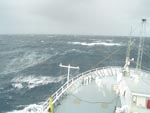
NIWA’s research ship, RV Tangaroa, has hosted a month-long, multi-organisation study of the ocean processes controlling climate change. The 30 scientists on board for the voyage in March/April 2004 came from 17 organisations in 6 countries to measure the exchange of gases between the ocean and atmosphere and the link to biology.
The location of the experiment was the Southern Ocean, which plays an important role in climate processes. For example, if the oceans did not soak up some of the carbon dioxide generated by human activity, climate change would be much more rapid than at present. The Southern Ocean makes a globally important contribution to the uptake of carbon dioxide because the cold water temperatures and strong wind and wave activity in the region aid the transfer of gases between the atmosphere and ocean.
One of the methods we used to measure gas exchange was to add tracer gases (sulfur hexafluoride and helium-3) to the water and measure their rate of transfer back into the atmosphere. The Southern Ocean lived up to its reputation and provided us with the opportunity to gather measurements at higher wind speeds than have previously been sampled anywhere else using this dual-tracer technique.
Biology also plays an important role. Phytoplankton take up carbon dioxide as part of photosynthesis, and also release the gas dimethyl sulphide (DMS), which affects cloud properties. On this voyage we attempted to stimulate this effect by fertilising a region of the ocean that was rich in nutrient but low in chlorophyll. One of the really intriguing aspects of this voyage was the very slow biological growth even after we infused the study region with 5.5 tonnes of iron sulphate “fertiliser” mixed in 30 tonnes of acidified seawater. Such a slow response has not been observed in earlier iron-enrichment experiments. Our understanding of this will provide new insights into iron fertilisation of the oceans.
The experiment was a part of SOLAS (Surface Ocean–Lower Atmosphere Study), a new international research programme. A diary of the voyage was posted on NIWA’s website.
For more information, contact: Mike Harvey or Murray Smith NIWA, Private Bag 14901, Wellington ph +64 4 386 0300 [email protected]

Kelp on reefs under the February 2004 flood
When the February 2004 floods inundated much of the southwest North Island, the deluge on land captured most of the attention, but there were also spectacular effects underwater. During the floods, we had oceanographic instruments deployed in the shallow subtidal zone near New Plymouth for a research project investigating kelp–oceanography interactions. The data collected provide an indication of the duration and intensity of flooding, and how events on land may extend offshore.
Little is known about subtidal reefs in north Taranaki for a good reason: the sea is constantly rough and murky. Initial work indicated that kelp grew in shallow areas with consistently strong wave action. We installed light and current meters for 3 months over summer to obtain measurements of the physical conditions at sites with kelp forests. The storms of February 2004 provided good evidence of how severe conditions can be on Taranaki reefs.
For 2 weeks (12–26 February) the seabed was dark. In December and January there had been short periods (2–3 days) when little light reached the seabed, but the February event completely overshadowed those earlier disturbances.
Our study shows that floods can have ecologically relevant effects underwater, without sediments accumulating on the seabed. Our observations suggest that kelp populations at depths of 10 m can tolerate low light for at least 2 weeks before the plants start to suffer. However, acclimation to the local light climate probably occurs. Our investigations continue into how such severe events affect reef ecology.
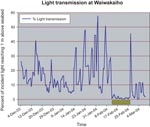
Russell Cole, Niki Alcock, Matt Pinkerton (NIWA), Peter McComb and Tim Haggitt (Artificial Surf Reefs Ltd)
For more information, contact: Russell Cole NIWA, PO Box 893, Nelson ph +64 3 545 1715 [email protected]

Recent publications by NIWA staff
Lists of the most recent publications by NIWA staff are compiled each month and posted on the NIWA website. These lists include papers published in refereed journals, proceedings, books and book chpters, as well as conference and seminar presentations and popular articles.
